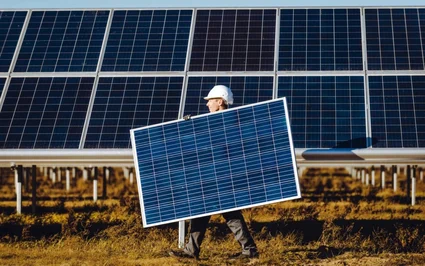For Independent Power Producers (IPPs) who acquire solar assets post-development and design, there are indeed fewer chances to address design flaws or optimize value through engineering. However, engaging an Owner's Engineer (OE) or Independent Engineer (IE) early in the process remains crucial to ensure safety, quality, and long-term operational efficiency.
In the first segment of this two-part series, I highlighted strategies for leveraging third-party engineering expertise during the initial stages of project development. Now, in the second part, I’ll focus on how Pure Power adds value to IPPs specifically during and following construction.

### IE or OE Engaged During Construction
The transition from pre-construction to actual construction begins when the Engineer of Record finalizes the "Issued for Construction" (IFC) drawings. At this stage, the main objective of independent or owner’s engineering services shifts toward ensuring that what’s being built aligns with the originally promised design.
Engaging Pure Power early—whether as an OE or IE—maximizes our ability to contribute effectively. Ideally, quality assurance (QA) and quality control (QC) checks should start from the very first days of construction. Catching issues early on, while the project is still in its infancy, is far simpler than addressing them after significant work has been completed.
#### Quality Assurance and Control
One critical aspect of QA/QC involves verifying that the as-built conditions match the IFC design drawings and project specifications. This includes both visual inspections and specific tests like insulation resistance, VLF testing, polarity checks, and ground continuity tests. These preliminary evaluations are prerequisites for system energization and commissioning.
During commissioning, all major components—inverters, protection devices, transformers, reclosers—are tested according to manufacturer guidelines, which are typically aligned with standards set by organizations like NETA or IEC. For instance, IEC 62446-1 outlines comprehensive requirements for testing, documentation, and maintenance of photovoltaic systems.
#### Milestone Verification
Key construction milestones, such as mechanical or substantial completion, usually coincide with substantial financial payouts. Lenders often hire Pure Power during construction to produce independently verified reports confirming milestone achievements. Additionally, as an OE, we offer on-site milestone visits tailored to the needs of our clients. Once these payments are released, the project owner or lender loses the leverage to enforce compliance with original designs or contracts.
#### Performance Validation
Properly executed capacity and performance ratio tests serve as essential tools for mitigating risks associated with solar asset acquisitions. Whether the system is newly constructed or already operational, these tests confirm that the solar asset functions as intended, thereby reducing uncertainties for potential buyers.
---
### IE or OE Engaged During Post-Construction
When IPPs specialize in acquiring operational assets, they require specialized technical due diligence to assess existing conditions accurately. This applies equally to recently completed systems and those that have been operational for several years. After construction wraps up and commercial operations commence, validating the PVsyst model becomes just as vital as evaluating the fielded design and build.
Ideally, the operational system should be free from defects and safety hazards. Acquiring assets post-operation demands a thorough examination of the system’s current state to identify any discrepancies between planned and actual implementations.
#### As-Built Drawing Review
Mismatched record drawings and as-built conditions pose significant risks to project owners and operators. They can lead to unnecessary costs that could have been avoided. Reviewing these drawings is therefore a fundamental step in asset acquisition. The aim here is to ensure that the physical system matches its documentation.
#### Performance Analysis
Since solar asset revenues hinge entirely on the accuracy of the PVsyst model, it’s imperative to validate and adjust this model to reflect real-world performance. This is particularly relevant when acquiring assets after a year or more of operation. Older systems may exhibit varying degrees of soiling, degradation, and availability compared to newer installations. By incorporating factors such as landscape changes (e.g., tree growth) and advanced modeling software, Pure Power can enhance the precision of performance models for aging systems.
#### Safety Evaluation
Post-construction, technical due diligence focuses heavily on ensuring the absence of safety hazards. This includes reviewing plans, conducting QA/QC checks, and performing field inspections. Ensuring regular maintenance and timely upkeep is crucial to prevent costly failures caused by prolonged wear and tear of fielded equipment. Such evaluations help safeguard the new owner’s investment by minimizing the likelihood of unexpected breakdowns.
---
In conclusion, regardless of when IPPs choose to engage engineering services—during construction or afterward—the key lies in proactive oversight and continuous improvement. Whether it’s enhancing safety, optimizing performance, or validating compliance, Pure Power stands ready to deliver tailored solutions that meet each client’s unique needs.
Electric Car
Electric vehicle (BEV) refers to a vehicle that is powered by an on-board power source and uses an electric motor to drive its wheels, meeting various requirements of road traffic and safety regulations. Due to its relatively small impact on the environment compared to traditional cars, its prospects are widely optimistic.
The main difference (difference) between pure electric vehicles and gasoline vehicles lies in the four major components: drive motors, speed controllers, power batteries, and on-board chargers. Compared to gas stations, it consists of a public ultra fast charging station. The quality difference of pure electric vehicles depends on these four major components, and their value also depends on the quality of these four major components. The use of pure electric vehicles is also directly related to the selection and configuration of the four major components.
Electric Car,New Energy Electric Vehicle,Electric Used Car,Mid Size Pure Electric Vehicle
Chongqing Huanyu Automobile Sales Company , http://www.huanyuauto.com